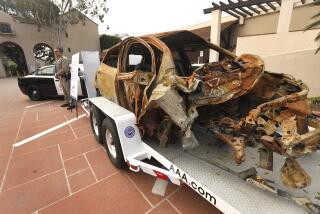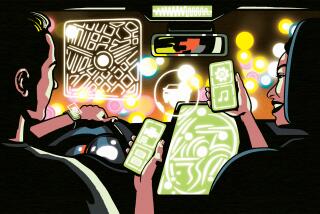TELEVISION ON THE MOVE : In-Car Video Screen Small But Critics Question Safety
- Share via
In the near future, motorists may see something entirely new when they look at their windshields--a television show that appears to float above the road. It may sound farfetched, but Jay Schiffman, an electrical engineer at Auto Vision Associates in Ferndale, Mich., has recently received a patent for a device that could make it possible.
Called AutoVision, the video system consists of a tiny mirror positioned on the windshield above the driver’s line of sight to reflect the picture shown by a small projector located near the dome light. “The whole thing depends on the size, position, and the shape of the mirror,” Schiffman said. “It is small enough to see around, mounted high enough on the windshield to see under, and the curve of its surface creates the illusion that the television image is hovering about 15 feet in front of the car.”
Beyond the feasibility of the technology, the obvious question of the safety of a car TV is already being debated by experts. The consensus so far is that the device appears to be safe but is not without potential dangers.
Its safety hinges on the optical illusion it creates, called a “virtual image” by psychologists, which makes AutoVision’s TV image seem to be just another part of the landscape. It is as if a small piece of the scenery had been cut out and a television screen put in its place. The illusion also makes the picture seem much larger than it actually is, allowing the driver to watch the screen comfortably without it monopolizing his attention.
In addition to whatever else the driver wishes to view, a small video camera mounted near AutoVision’s projection unit is pointed at the dashboard and feeds the projector. The device is used to display a picture of the dashboard onto the screen. By selecting this option, drivers can check their speed, adjust the air conditioning, or even tune the radio without taking their eyes off the road. This type of readout, known as a “head-up display,” has been used on jet fighters for over 30 years, and is claimed to make the operation of supersonic aircraft safer by allowing pilots to check their instruments while still watching where they are going.
People who have tested AutoVision say the matchbook-size mirror blocks far less of the windshield than the sun visor and is no more distracting than the overhead signs on a highway. However, the real magic of this invention may be the fact that it concentrates driver attention on the road ahead. “The view of the road surrounding the television image always remains in focus,” the inventor said, “and a driver whose interest is captured by what is going on in front of the car is not likely to let his eyes wander off the road.”
The panel of independent psychologists and traffic safety specialists now evaluating the device for AutoVision generally agree that there is little danger in having the mirror on the windshield. However, some members of the group have stressed the need for further research on what images should be shown and under what conditions the device should be used.
“I would have no objection to using this device to display a picture of the dashboard,” said Dr. Herschel Leibowitz, an experimental psychologist at Pennsylvania State University, who has tested AutoVision. “I can even see how the television function might be beneficial in stimulating drivers who are bored and in danger of falling asleep. However, misuse might be dangerous, especially if the driver was drinking, or was distracted in heavy traffic or with pedestrians present.”
The objection that watching television while driving will distract drivers and delay their reactions is the most common criticism of AutoVision. But Schiffman said, “We have been testing AutoVision for several years, and over 200 people have driven the prototype cars a total of 175,000 miles without a single incident. Our experience and research have shown that when a person watching AutoVision sees a potential hazard in the same visual area as the screen, he automatically shifts his attention to the problem. The first call of mankind is to preserve its own skin. It is a natural reaction.”
A driver can watch AutoVision and drive at the same time because most of the information needed to follow a television program comes from the audio portion of the broadcast. “You do a sort of time sharing, and actually look at the screen only a small fraction of the time,” explains the inventor. “But even when you glance at the picture to fill in some details, everything on the road ahead remains in full view and completely in focus.”
The idea for AutoVision first came to Schiffman while he was doing research on head-up display units designed for aircraft. In order to discover how these displays might be distracting to pilots, he installed one in a panel truck and began driving with it. “The electronics for that first unit took up almost the entire back of the truck, and while the research I wanted to do was never funded, I did discover that if I put the right type of image in the right location, I could safely drive while watching television.”
As his work progressed, and with the advent of transistors and printed circuits, Schiffman reduced the dimensions of the projection unit to the size of a book.
He also developed other types of head-up displays, such as the Bendix Blind Landing System (to which he holds the patent), a device that allows pilots flying in fog to see an electronically generated image of the runway they are approaching. But even with this impressive background, he had to work at convincing scientists, traffic officials and investors that his invention was practical. “Most of them found the idea of AutoVision hard to believe, but when I got them in a car and let them drive with it, they immediately saw its possibilities.”
Schiffman believes that the story of AutoVision could very well parallel that of the car radio. In 1929, Bill Lear (later of jet aircraft fame) presented his boss, Paul Galvin, with the first radio designed for use in an automobile. Galvin’s immediate response was, “They’ll never be allowed in cars. There will be laws against them.” But Lear was determined, and despite predictions from traffic authorities in Washington that there would be nationwide bans on car radios, his invention was a success and formed the basis of what would later become the Motorola Corp. Some cities actually did pass laws against using radios while driving, but every one of these laws was eventually repealed, and today 95% of all cars are equipped with a radio.
With 300 million motor vehicles now operating worldwide and 30 million new cars being built each year, the economic possibilities for AutoVision are enormous.
“If the safety issues are resolved, the market for AutoVision should be similar to the one for car stereo systems,” said Ron Pherigo of the American Electronics Assn. But others fear that this is another multibillion-dollar industry that could be lost if the fear of liability suits forces the technology overseas, to Europe or Japan, where few laws exist that would limit the use of the device.
The safety consultants and traffic officials who have begun to evaluate AutoVision believe that some form of the apparatus could be used in cars in the near future. But no one is sure exactly what we will see when we look at that tiny screen. Some recommend that video cameras be used to televise the blind spots between a car’s mirrors, while others suggest that maps could be projected on the screen and the car’s location plotted by satellite.
“I can imagine it being used as an entertainment device, but with carefully defined programming,” said Prof. D. Alfred Owens, a psychologist specializing in human perception and traffic safety at Franklin and Marshall College. “This device provides an opportunity to develop an entirely new mode of broadcasting that considers the driver’s situation and actually enhances driver attention.”
If the television option is proved safe for widespread use, proponents say, AutoVision will change the way we experience driving. It can make extended trips seem shorter, calm people caught in traffic jams and even keep drivers alert during long, boring trips.
“Everything we need to know about this device can be researched,” Owens said. “In fact, if you will pardon the pun, this new technology is going to drive us to learn more about how humans operate automobiles.”






